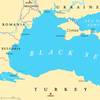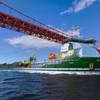Fincantieri Launches Indian Navy Ship
Fincantieri’s shipyard in Sestri Ponente (Genova) launched the second of two fleet tankers ordered by the Indian Navy, with delivery scheduled by the end of the next year. Present at the ceremony were Debabrata Saha, ambassador for the Republic of India in Italy and Alberto Maestrini, head of Fincantieri Naval Vessels Business Unit. First announced at Euronaval in 2008, the order is the first surface vessel India has ever made to a European company and followed a selection procedure with strong international competitors, especially from Russia and Korea.
At 175 mlong, 25 wide and 19 high, the fleet tanker is a supply and logistic support vessel with a displacement at full load of 27,500 tonnes and a propulsion system of two 10,000 kW diesel engines enabling her to reach a maximum speed of 20 knots. Notable features of the vessel are its propulsion system incorporating a shaft with adjustable pitch propellers and a flight deck for medium weight helicopters (up to 10 tons). Maximum passenger capacity is 250 including crew and additional forces.
Equipped with double hatches the tanker can refuel four vessels at the same time.
In accordance with the new Marpol regulations of the International Maritime Organization regarding protection of the environment, the ship has been built with a double hull. This will afford greater protection to the fuel tanks, thereby avoiding the risk of pollution in case of collision or damage.
Cooperation with India started in 2004 when Fincantieri drew up two contracts with Cochin shipyard for the design of an engine (one of the most powerful non-nuclear propulsion systems in the world), technology transfer and provision of complementary services for the construction of the Indigenous Aircraft Carrier (IAC). Furthermore, in 2007 the company delivered the “Sagar Nidhi”, an oceanographic vessel for the National Institute of Ocean Technology (NIOT) of Madras, which is already operating off the Indian coast to the great satisfaction of the customer.
Fincantieri considers the East market and the development of cooperation with the high prestige Indian partner to be strategic, as witnessed by two events – the opening in recent years of a representative office in New











